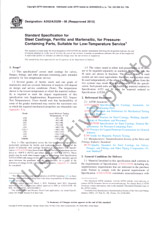We need your consent to use the individual data so that you can see information about your interests, among other things. Click "OK" to give your consent.
ASTM E3062/E3062M-19
Standard Specification for Indoor Ballistic Test Ranges for Small Arms and Fragmentation Testing of Ballistic-resistant Items
Translate name
STANDARD published on 1.5.2019
The information about the standard:
Designation standards: ASTM E3062/E3062M-19
Note: WITHDRAWN
Publication date standards: 1.5.2019
SKU: NS-949499
The number of pages: 4
Approximate weight : 12 g (0.03 lbs)
Country: American technical standard
Category: Technical standards ASTM
The category - similar standards:
Annotation of standard text ASTM E3062/E3062M-19 :
Keywords:
ballistic test range, ballistic test range configuration, projectile velocity, small arms,, ICS Number Code 95.060 (Weapons)
Additional information
| 1. Scope |
|
1.1 This standard specifies indoor ballistic test range requirements for small arms and fragmentation testing of the following ballistic-resistant items: soft body armor, hard armor plates, body armor accessories, shields, and helmets. The specification includes requirements for range geometry (for example, dimensions, alignment, spacing), range conditions (for example, temperature, humidity, lighting), test equipment (for example, receiver, mounting, test barrels, backing assembly mounting), instrumentation (for example, light screens, high speed cameras, radar), and measurement procedures (for example, projectile velocity, yaw). 1.2 The purpose of this standard is to specify critical test range parameters in order to achieve consistency/repeatability among test ranges. 1.3 This specification is not applicable for “contact” shots taken on the test item (that is, the muzzle rests on the strike face of the test item). 1.4 Units—The values stated in either SI units or inch-pound units are to be regarded separately as standard. The values stated in each system are not necessarily exact equivalents; therefore, to ensure conformance with the standard, each system shall be used independently of the other, and values from the two systems shall not be combined. 1.4.1 The user of this standard will identify the system of units to be used, and it is critical to ensure that any cross-referenced standards maintain consistency of units between standards. 1.5 This standard does not address environmental concerns, if any, associated with its use. It is the responsibility of the user of this standard to establish appropriate practices and determine the applicability of regulatory requirements prior to use. 1.6 This standard does not purport to address all of the safety concerns, if any, associated with its use. It is the responsibility of the user of this standard to establish appropriate safety, health, and environmental practices and determine the applicability of regulatory limitations prior to use. 1.7 This international standard was developed in accordance with internationally recognized principles on standardization established in the Decision on Principles for the Development of International Standards, Guides and Recommendations issued by the World Trade Organization Technical Barriers to Trade (TBT) Committee. |



 Cookies
Cookies
